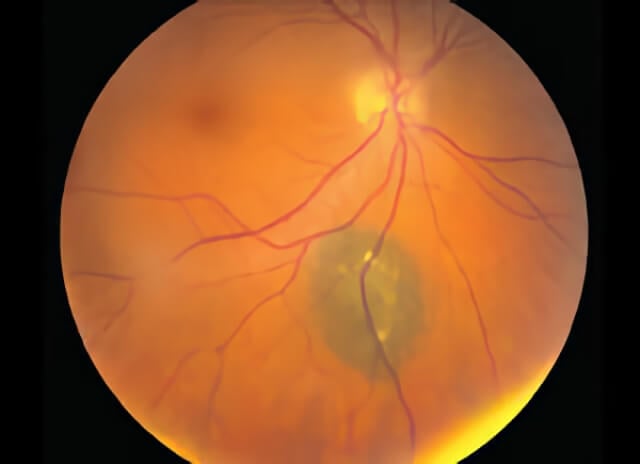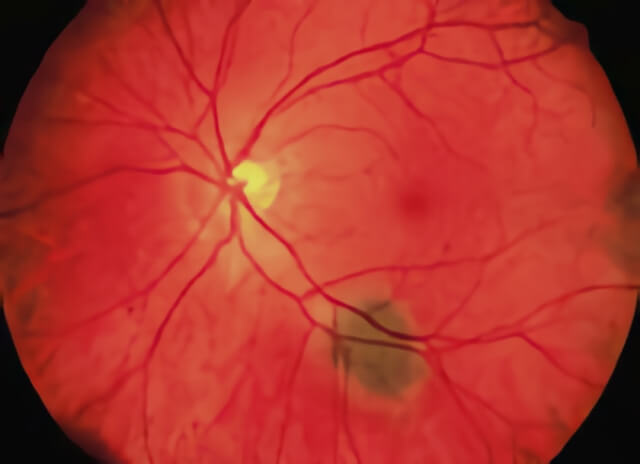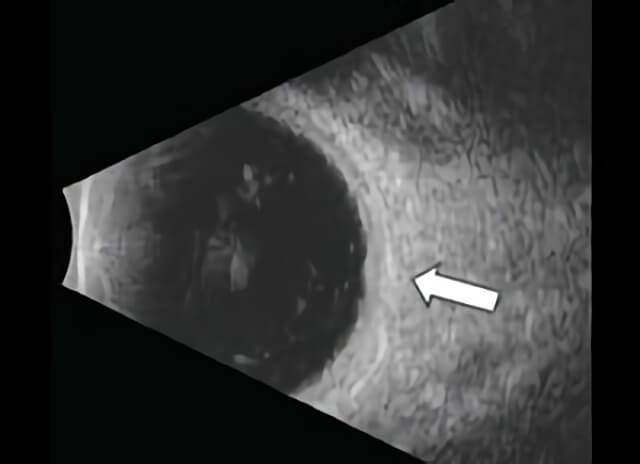Choroidal Nevus
What is a choroidal nevus?
Nevus is the medical term for a birthmark. Just as freckles, moles, and birthmarks can occur on your skin, a nevus can also be found inside your eye. They are most often seen in the pigmented layer beneath the retina called the choroid. A choroidal nevus can only be seen by an eye care specialist using specialized tools to see inside your eye.

Choroidal nevi typically appear as brown or brown-grey patches of pigment underneath the retina. Some, like the one pictured here, have small pale yellow or white spots on them, called drusen.
Learn more about Choroidal Nevus
Is a choroidal nevus dangerous?
Most choroidal nevi remain benign and cause no problems. Just like freckles and moles on your skin, a choroidal nevus can rarely grow into a malignant melanoma. About one in five thousand nevi grows into a melanoma.
Should I have my nevus treated?
Most choroidal nevi do not require treatment. Some choroidal nevi have features that make them higher risk for growing into a melanoma and these nevi should be watched carefully by periodic re-examination with your doctor. Your doctor will carefully document these features and decide how often you need to be re-examined.
How often should I get re-examined to know if my nevus is changing or growing?
All choroidal nevi should be examined at least once a year. If your doctor notices certain features on your nevus, you may need to be checked more often. For example, if the nevus is particularly large or thick, has orange pigment, or is leaking fluid, then it is more likely to grow into a melanoma. Your doctor will decide how often to recheck your nevus to decide if it has grown into a melanoma.

A benign appearing choroidal nevus is present in this photo as a dark patch under the retina.
What needs to be done to check my nevus?
All choroidal nevi require careful examination and documentation by an eye doctor. Some nevi require additional testing. This may include the use of an ultrasound of the eye, specialized photography, or an angiogram of the inside of the eye1. These tests are useful to carefully document the size, shape, and characteristics of your nevus to determine if it has changed or is staying the same on future examinations.

An ultrasound image of the eye shows a tiny nevus under the retina that is visible as a slight bump (arrow).
Does a choroidal nevus affect my vision?
Almost always, a nevus causes no visual symptoms. Rarely, a nevus can cause a blind spot in the vision of one eye, but this rarely affects a patient’s day to day vision. Sometimes visual changes are a sign of other problems or that a nevus has begun to change into a malignant choroidal melanoma. Any visual changes should prompt a careful examination by your doctor.
References
- Shah AR. Widefield Imaging Finds Its Place in the Practice. Retina Specialist. November 2015; Accessed January 2022: retina-specialist.com/article/widefield-imaging-finds-its-place-in-the--practice
Schedule Choroidal Nevus Treatment in Northern California with Retinal Consultants Medical Group
Since 1975, Retinal Consultants Medical Group has been providing outstanding care to patients throughout Northern California, including Sacramento, Modesto, and Stockton. Our retina specialists and surgeons treat multiple vitreoretinal conditions, such as age-related macular degeneration and diabetic retinopathy. We invite you to contact us with any questions or schedule an appointment today.


